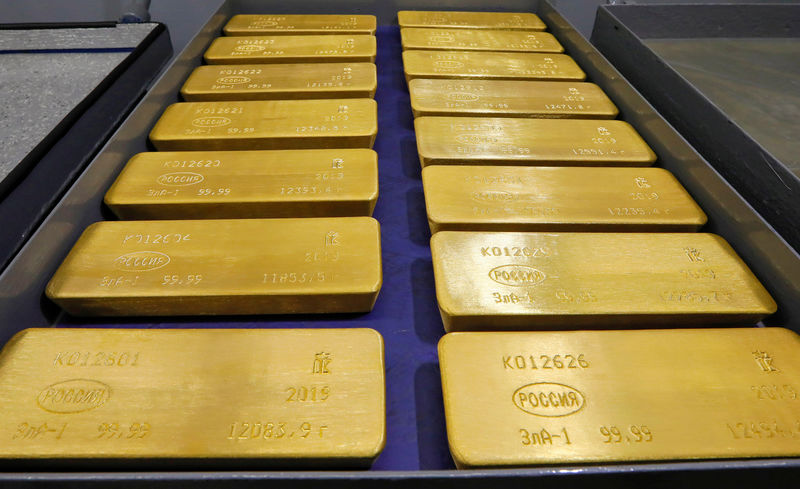Commodities
Gold prices rise even as Fed shoots down early rate-cut hopes


© Reuters.
Investing.com– Gold prices rose on Thursday and were undeterred by the Federal Reserve stating that it will likely keep interest rates higher for longer, while safe-haven buying amid an ongoing conflict in the Middle East also aided the yellow metal.
The Fed’s comments spurred a sharp reversal in risk-driven markets, particularly stocks, on Wednesday. This in turn fueled increased safe-haven demand for gold. The yellow metal was also aided by increased demand as a conflict between U.S.-led forces and the Yemen-based Houthi Group worsened.
rose 0.3% to %2,045.21 an ounce, while expiring in March fell 0.2% to $2,062.40 an ounce by 00:22 ET (04:22 GMT). The disparity highlighted more near-term demand for physical gold.
Further gains in the yellow metal were held back by a sharp rebound in the , which traded close to seven-week highs.
Fed’s Powell downplays March rate cuts; Markets see cuts in May
Fed Chair Jerome Powell said it was too soon for the central bank to consider trimming interest rates, especially as soon as March, given that inflation was still running sticky.
But this hawkish rhetoric was somewhat countered by Powell still leaving the door open for eventual reductions in interest rates this year. Powell also noted continued resilience in the U.S. economy, and that he expected inflation to fall further in the coming months.
Powell’s comments fueled increased bets that the Fed will begin trimming rates by May. The showed traders pricing in a 63% chance for a 25 basis point cut in the Fed’s May meeting. The tool also shows traders pricing in greater possibility that the U.S. benchmark rate will end 2024 in a range of 3.75% to 4.0%, down from its current high of 5.25% to 5.5%.
Goldman Sachs analysts forecast a May rate cut, and maintained their outlook that the Fed will cut rates a total five times in 2024.
The prospect of lower lending rates bodes well for gold, given that higher rates ramp up the opportunity cost of buying bullion.
Copper prices cool after rallying to 1-mth high, China outlook mixed
Among industrial metals, copper prices fell on Thursday as traders locked-in profits from a rally to one-month highs in the prior session.
expiring in March fell 0.6% to $3.8705 a pound.
A recent rally in the red metal was driven chiefly by increased optimism over China, as the world’s largest copper importer rolled out more stimulus measures to support an economic recovery.
But data prints for January showed sustained economic weakness. Official released on Wednesday showed the manufacturing sector remained in contraction, while a released on Thursday pointed to stagnating growth in the sector.
A deepening crisis in China’s property sector also dented sentiment, after beleaguered developer China Evergrande Group (HK:) was ordered by courts to liquidate.
Commodities
Oil prices rise; U.S. crude inventories plunge, Russia-Ukraine truce eyed
Commodities
India’s Reliance to stop buying Venezuelan oil over US tariffs, sources say
Commodities
Oil prices climb on Venezuela supply worries

 Forex3 years ago
Forex3 years agoForex Today: the dollar is gaining strength amid gloomy sentiment at the start of the Fed’s week

 Forex3 years ago
Forex3 years agoUnbiased review of Pocket Option broker

 Forex3 years ago
Forex3 years agoDollar to pound sterling exchange rate today: Pound plummeted to its lowest since 1985

 Forex3 years ago
Forex3 years agoHow is the Australian dollar doing today?

 Cryptocurrency3 years ago
Cryptocurrency3 years agoWhat happened in the crypto market – current events today

 World3 years ago
World3 years agoWhy are modern video games an art form?

 Commodities3 years ago
Commodities3 years agoCopper continues to fall in price on expectations of lower demand in China

 Economy3 years ago
Economy3 years agoCrude oil tankers double in price due to EU anti-Russian sanctions



























